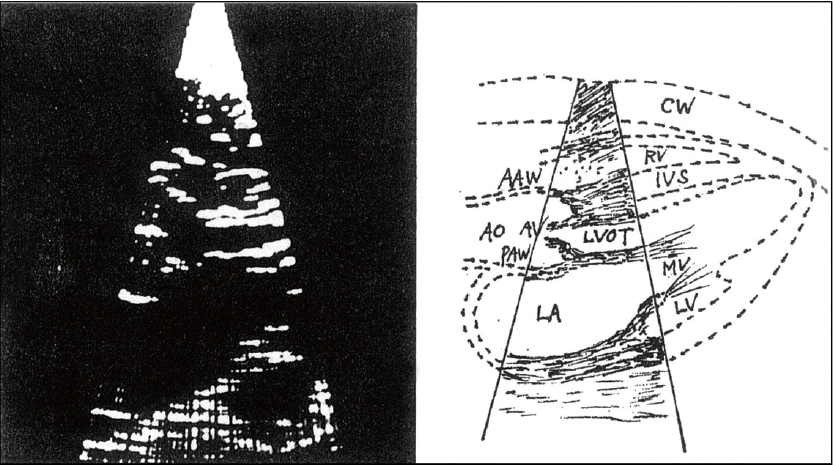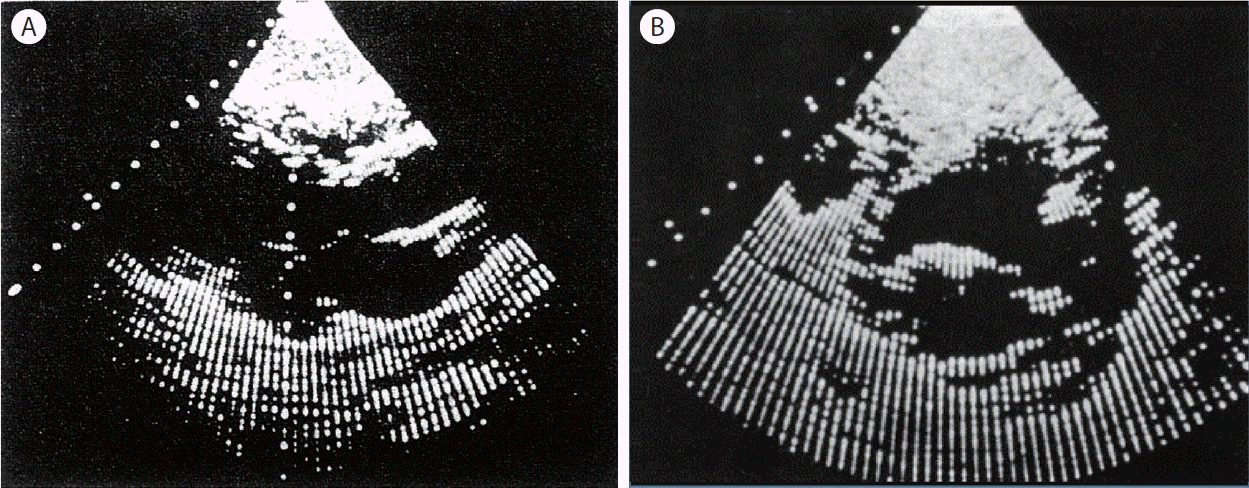한국에서 초기 이면성 심초음파 실상 보고(1977-1981)
The Early Days of Two-Dimensional Echocardiography in Korea (1977-1981)
Article information
Trans Abstract
Today, echocardiography is an essential non-invasive diagnostic imaging tool used in clinics worldwide. However, the application of ultrasound to the heart began only about 70 years ago. In the early 1950s, Hertz and Edler described the use of ultrasound for myocardial walls and mitral valve diseases. Feigenbaum (1960s) expanded the clinical use of M-mode echocardiography. The advent of two-dimensional (2D) echocardiography (1970s), spectral Doppler (1970s), and color Doppler (1980s) established them for routine assessment of cardiac anatomy and hemodynamics. In Korea, the history of 2D echocardiography spans only 46 years, within living memory, and some early contributions are often overlooked. The initial 2D imaging using mechanical sector scanning was very different from the current electronic phased-array scanners. This review explores the historical status and actual images of the initial 2D echocardiography in Korea in 1977-1981.
서 론
긴 의학사의 흐름에서 보면, 초음파를 심장에 적용하기 시작한 것은 불과 70여 년 전으로 비교적 짧다[1,2]. 최초로 초음파가 임상 진단에 도입된 분야는 뇌로, 오스트리아 신경 정신과 의사 Dussik은 1942년, 인간의 뇌실 검사에 진단용 초음파(hyperphonography of brain)를 적용하였다[3]. 이후 1950년 초음파는 심장 분야에 적용되었는데, 독일 의사이자 생리학자 Wolf-Dieter Keidel은 전송된 음파를 기반으로 음향 그림자와 심장 용적 및 기능과의 상관관계를 보고하였다[2]. 심장의 반사 초음파(reflected ultrasound)로 영상을 만드는 임상 심초음파(clinical echocardiography)의 효시는 Carl Helmuth Hertz와 Inge Edler로, 그들의 1954년 초음파 반사경(ultrasonic reflectoscope)을 이용한 심장벽 움직임에 대한 연구는 널리 알려져 있다[4]. 그리고 현대 심초음파의 아버지라 불리우는 Harvy Feigenbaum 박사는 M-mode로 심낭 삼출액을 진단하는 등 연구, 교육, 심초음파 교과서 편찬(1972), 심초음파 분과 설립(1965), 미국심초음파학회 설립(1975) 등으로 심초음파의 보급과 학문적 발전의 기틀을 마련하였다[5,6].
한국에서 임상 심초음파의 효시는 1968년 11월 김삼수 교수가 Smith-Kline Ekoline 20 초음파 기기(Smith Kline Instruments, Sunnyvale, CA, USA)로 승모판 협착증 및 심낭 삼출 환자에서 M-mode 심초음파를 시행하여 진단한 것이다[7]. 당시 신경외과에서 뇌질환 진단에 사용하고 있었던 A-mode 초음파를 국내에서 처음으로 심장에 M-mode로 응용하였던 것으로, A-mode 초음파를 먼저 심장에 발사시킨 후, 움직이는 심장의 각 부위로부터 반사된 파가 오실로스코프(oscilloscope)에서는 15 cm 수직 선상에서 여러 개의 점들이 상하로 움직이는 것이 나타나게 되는데, 이 때 폴라로이드(polaroid) 필름을 서서히 움직이게 하여 기록 인화시켜 M-mode 심초음파 영상을 나타나게 하는 매우 까다로웠던 조작을 하였다. 이는 현재 쉽게 이용하는 M-mode 영상 기록 조작과는 차이가 난다. 그리고 국내에서 이면성 심초음파는 1977년 김종성 교수가 처음으로 수행하였다[8].
본 종설에서는 잊힐 수 있었던 한국에서의 이면성 심초음파 초기(1977-1981) 실상을 국내 이면성 심초음파의 효시인 김종성 교수의 영상 자료와 더불어 나누고자 한다.
본 론
초기 이면성 심초음파: 30도 또는 80도 영상
미국 인디애나 대학 Feigenbaum 박사는 그의 저서 심초음파 제2판(1976)에 부채꼴 스캔 각도(sector scan angle)가 30도인 이면성 심초음파도를 정리하여 소개하였다[9]. 국내에서는 김종성 교수(부산대학교 의과대학, 1969-1979)가 1977년 9월에 기계식 섹터 스캐너(mechanical sector scanner, Ekosector I), SKI Ekoline 20A (Smith Kline Instruments)로 처음 이면성 심초음파 검사를 하였는데[8,10,11], 마찬가지로 30도 각도의 좁은 이면성 초음파 영상을 구현하였다.
SKI Ekoline 20A 또는 21A 초음파 기기와 2.5 MHz의 기계식 30도 섹터 스캐너를 이용하여, 김종성 교수가 1977-1979년에 기록한 이면성 심초음파도의 예를 제시한다(Fig. 1-4).

Normal two-dimensional echocardiograms using the mechanical 30° sector scanner [10]. Long-axis cross-sectional images include the mid-left ventricle (A) and the aortic valve (B). Short-axis cross-sectional images of the mid-ventricular (C) and aortic valve levels (D). RV, right ventricle; Vent, ventricular; LV, left ventricle; Post., posterior; Ant., anterior; LA, left atrium.

Mitral valve stenosis [11]. Two-dimensional echocardiograms using the mechanical 30° sector scanner. Both long-axis (A) and short-axis (B) cross-sectional images reveal the reduced separation of the mitral valve leaflets. RV, right ventricle; Ao, aorta; IVS, interventricular septum; LV, left ventricle; LA, left atrium; MV, mitral valve; PLV, posterior left ventricular wall; AMV, anterior mitral valve; PMV, posterior mitral valve.

Carpentier-Edwards valve [11]. Two-dimensional echocardiograms using the mechanical 30° sector scanner. Both long-axis (A) and short-axis (B) cross-sectional images reveal a Carpentier-Edwards (C-E) prosthetic valve in the mitral position. RV, right ventricle; IVS, interventricular septum; LV, left ventricle; Post, posterior.

Hypertrophic cardiomyopathy [11]. Two-dimensional echocardiogram using the mechanical 30° sector scanner. A long-axis cross-sectional image from the left ventricular outflow tract (LVOT) in a patient with hypertrophic obstructive cardiomyopathy. A narrow LVOT and thickened basal interventricular septum (IVS) are noted. CW, chest wall; AAW, anterior aortic wall; RV, right ventricle; Ao, aorta; PAW, posterior aortic wall; LA, left atrium; MV, mitral valve; LV, left ventricle.
1960년대 후반에서 1970년대 초반에 걸쳐 개발된 이면성 심초음파의 초기 버전은 30도 기계식 섹터 스캐너로 운용되었는데, 이는 전기 모터에 의해 빠르게 진동하도록 만들어진 단일 결정체 변환기(single crystal transducer)로 되어 있었다. 좁은 각도의 제한된 초음파 이미지란 것이 영상 판독에 어려움을 주었고, 검사 중의 소음과 환자가 느끼는 진동감(vibrating sensation)도 상당하였다. 또한 소프트웨어 및 전자 기술적 측면에서도 어려움이 있었다. 1977년 30도 이면성 심초음파 적용 시에는 비디오 테이프 녹화기(video tape recorder, VTR) 기술이 지원되어 있지 않아서, 베타맥스(Betamax, 소형 기계식 VTR)의 폭이 좁은 12.7 mm의 비디오 테이프에 녹화된 영상을 재현시켜 암실에서 18 mm 네거티브 필름(negative film)을 포지티브 필름(positive film)으로 현상시킨 후, 18 mm 영사기를 들고 다니면서 국내 학회에 발표하였다. 비록 좁은 영상의 각도(30도)에 해상력이 좋지 않아 둔탁한 이미지로 보였지만, 당시에는 심장의 내부 구조를 이면성 초음파 영상으로 관찰하였다는 점에서 M-mode로부터 한 차원 높은 혁신을 가져왔다고 할 수 있다.
이후 다중 회전 결정체(multiple rotating crystals)를 사용하는 넓은 각도 기계식 섹터 스캐너가 개발되면서 이전의 한계점들을 다소 극복할 수 있었다. 국내에서는 김종성 교수(인제대학교 의과대학, 1979-1986)가 1979년 8월, 부채꼴 스캔 각도가 80도인 이면성 심초음파(SKI Ekoline 21A, Smith Kline Instruments)를 처음으로 임상 질환 진단에 사용하였는데[12-14], 영상은 80도로 조금 더 넓어지긴 하였지만, 역시 기계식 스캐너를 사용하였기에 이면성 초음파 영상은 거칠면서 세련되지 못한 느낌을 주었다.
SKI Ekoline 21A 초음파 기기와 기계식 80도 섹터 스캐너를 이용하여, 1979-1981년 김종성 교수가 기록한 이면성 심초음파도의 예를 제시한다(Fig. 5-7).

Mitral valve stenosis. Two-dimensional echocardiograms using the mechanical 80° sector scanner. (A) Parasternal long-axis view, (B) parasternal short-axis view, (C) apical 4-chamber view, (D) subcostal view of a patient with mitral valve stenosis. LV, left ventricle; LA, left atrium; MV, mitral valve.
이면성 심초음파 이미징의 획기적인 전환점은 실시간 연속적으로 뛰는 심장 영상을 가능하게 해준, 전자식 섹터 스캐너의 개발이라 하겠다. 세계 최초의 전자식 위상배열 스캐너(electronic phased-array scanner)는 1968년 Jan Somer에 의해 개발되었고[15], 여기에 보다 넓은 부채꼴 각도(wider sector angles) 영상 기법도 추가되었다[16]. 국내에서는 1980년 3월 배종화 교수(경희대학교 의과대학, 1973-2006)가 Toshiba SSH-10A 전자식 위상배열 스캐너(Toshiba Medical systems, Tokyo, Japan)를 이용하여 각도가 현대와 유사한 이면성 심초음파 영상을 기록하였으며, 1981년에 우심실 점액종을 처음 보고하였다[17]. 1981년 이후 전자식 스캐너가 부착된 이면성 심초음파 기기가 널리 보급되었는데, 이는 실시간 이면성 심초음파 이미징을 가능하게 하였고, 영상의 질을 크게 향상시켰다. 한국에서 초기 이면성 심초음파의 발전 과정은 Table 1과 같다.
결 론
한국에서 초기 이면성 심초음파는 현대의 것과는 사뭇 다르다. 1970년대 후반은 M-mode의 일차원적인 정보에서 이면성 심초음파도의 이차원적 공간 정보를 볼 수 있게 된 초음파 역사상 획기적인 전환기였고, 한편으로는 30도 기계식 섹터 스캐너의 이미지 한계를 80도 기계식 섹터 스캐너와 전자식 위상배열 섹터 스캐너로 극복해가는 시점이기도 하였다. 이후 1985년 국내에 도플러 심초음파가 도입되어 심장의 구조뿐만 아니라 혈역학적인 평가가 가능하게 되었고[18], 컬러 도플러, 경식도 초음파, 조영 초음파, 조직 도플러, 삼차원 초음파, 반점 추적 스트레인, 휴대용 포켓 초음파에 이르기까지 초음파는 빠르게 진화되고 있다.
한국의 심초음파 역사는 55년으로 길지 않지만, 초기 열악한 환경에서 초음파의 유용성을 인지하고 이를 심장 질환 진단에 적용하려 부단히 노력하셨던 선구자분들의 노력이 기억되었으면 한다.


